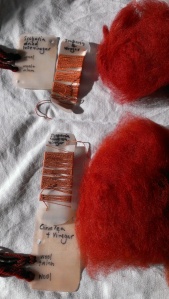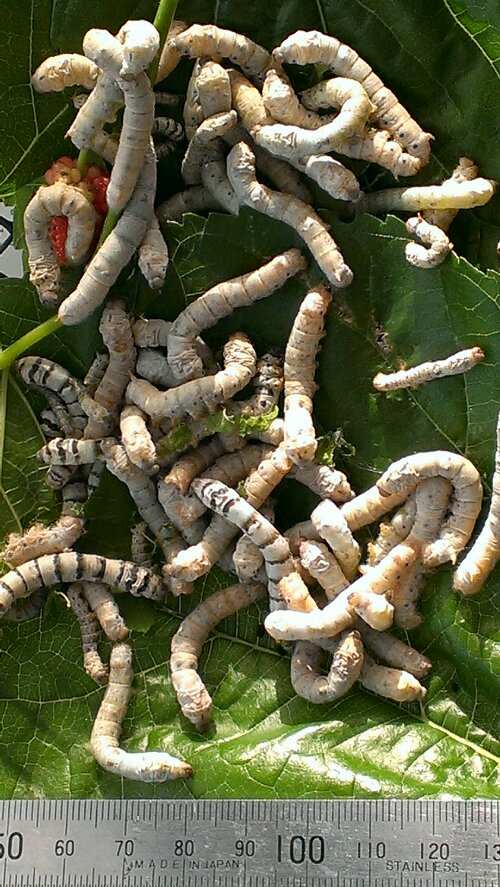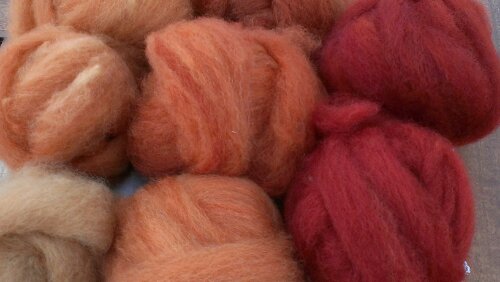I’ve spent a good deal of time trying to figure out how to get stronger colours, and especially red to burgundy, from Eucalypts. I’ve had occasional, but not dependable, success.
I have had the thought that the temperature of a dye bath might affect the colour obtained from eucalypts several times. In particular, I’ve had the thought that relatively low temperatures might be required to obtain reds. Bear with me in my ignorance about chemistry… I’ve had this idea when thinking about the way that madder turns toward brown if heated too much. The chemical constituents are not the same, but perhaps their reaction to heat could be. I’ve had the same idea reading the inspiring Karen Casselman’s Craft of the Dyer, in which she mentions that tannin bearing plant dyes will move toward brown if overheated. I’ve certainly obtained many oranges from boiled eucalypt dyebaths. I had this idea about reds and temperature again reading this glorious and informative post by Dustin Kahn and her comments. I had it when reading Ravelry and coming across very infrequent references to people achieving red from eucalypts of unknown variety, in which I’ve noticed slow cooker or crockpot methods seem to get success sometimes, suggesting low temperatures and long processing. I’ve noticed that when I’ve achieved red or maroon shades I’ve considered temperature to be a factor sometimes.
I used to use two gas burners that would do ‘boiling hard’ or ‘blowing out’ with only luck in between, and a lot of turning on and turning off to manage my results. Now that I have hobs that will allow relatively finely tuned temperature control, I think it is time to test this theory a bit more systematically. I’ve tried to test it before and been unable to replicate anything close to red. More recently I tested it again and felt that while keeping the pot at a simmer close to but below boiling is a good idea in order not to create felt, the lower temperatures I trued did not generate reds and sometimes were too low for good fixation. For the time being I am letting go of my temperature theory. So what are the other factors?
It is beyond question that the variety of eucalypt will predict the range of colours that are possible. I have best results with E Scoparia, E Cinerea, E Kingsmillii Alatissima and E Sideroxylon in the red range and of these, the best is E Scoparia bark in my own experiments.
I’ve found that sheer quantity of dyestuff to fibre is a factor in achieving any strong colour, certainly including red, but it is not a guarantee. Dustin Kahn reported using 340g fresh E Sideroxylon leaves and stems to 10g yarn to obtain brick red (and then achieved yellow and orange on two other 10g skeins). I am convinced that time is a factor. Rebecca Burgess and Dustin Kahn both report heating their dyestuffs for long periods with cooling in between (which I have found changes the colour but not in a red direction necessarily). The redoubtable Ida Grae reports achieving red from E Cinerea only after 3 hours of simmering.
India Flint recommends acidity as influencing brightness of colour, but I have to admit having tried it without being confident it made a difference–hence, more experiments needed, preferably with higher acidity levels. At a recent workshop, we had two E Scoparia bark pots running. We did a trial and put vinegar in one pot and not the other. The no-vinegar pot gave brown on alum mordanted superwash wool and alum mordanted alpaca. Brown surprised me, but I wouldn’t usually use alum. We’d run out of unmordanted wool in the mix that day. In the with-vinegar pot, grey handspun wool with no mordant came out burgundy, which was very exciting! Polwarth locks with no mordant came out brilliant orange, and the alum mordanted skeins of alpaca and alpaca blends came out toward the red end of orange. We cooked them on as low a heat as we could–but the no vinegar pot was bigger, so heat control was easier.
So… I am continuing to experiment with favourite species, no excessive heat (wasteful in any case), a high ratio of dyestuff to fibre and acidity.
Here are the latest findings: red on alpaca! Burgundy on the wool samples, rosy pink and orange on silk thread. The top sample used E Scoparia (dried leaves) and The lower samples used dried E Cinerea leaves, both with white wine vinegar.










